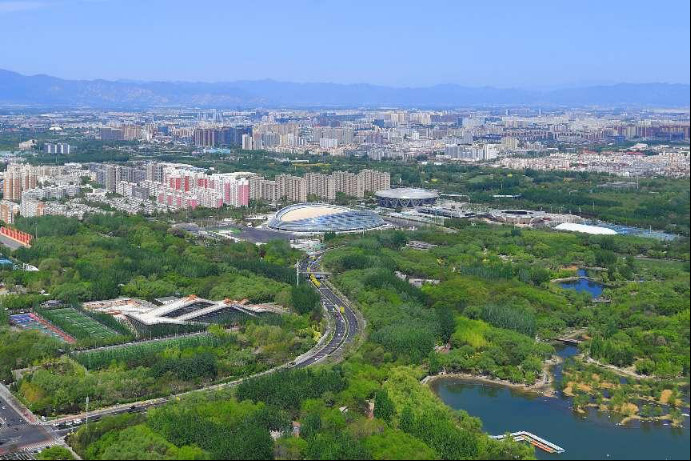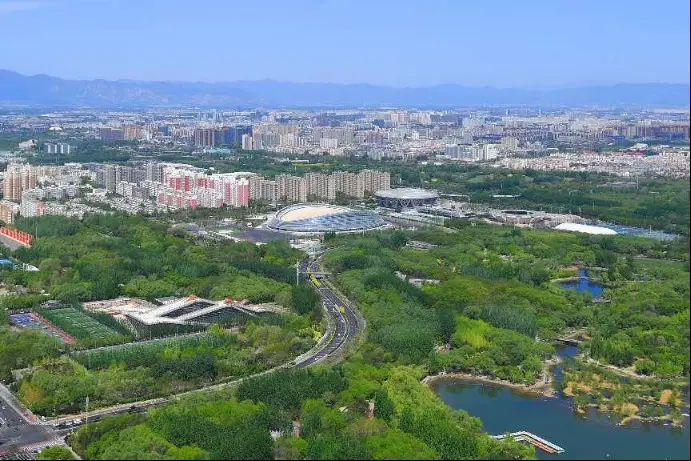By Li Zhen

Photo taken on April 22, 2022 shows the National Speed Skating Oval surrounded by trees in Beijing. (Photo by Sun Lijun/People's Daily Online)
Entering the Beijing-Chongli Expressway from the northern road of the capital, you'll see a vast number of green trees standing on the two sides of the road and extending all the way to the mountains at the end of your horizon.
These years, birds, hedgehogs, squirrels and rabbits have been frequently spotted in the woods along the expressway. "Many animals that had disappeared for years have returned. Even pheasants and roe deer are attracted here from the mountains," said a nearby villager.
These trees make the Beijing-Chongli Expressway a green corridor, which is part of Beijing's new round of afforestation work of one million mu (about 66,667 hectares) that started in 2018.
The new round of afforestation work aims to improve urban ecology and build a high-quality, healthy and stable forest ecological system. It has helped Beijing build an ecological network, which improves biodiversity, expands green space and optimizes the living environment of the city over the past five years.
The work takes the existence of wild animals into full consideration. By connecting areas that were once ecologically separated, it has gradually built a "green network" that offers larger habitats and more migration channels for animals.
"We must make sure that rabbits from Tongzhou district can jump all the way to Yanqing district," said Wang Xiaoping, an official with the Beijing Gardening and Greening Bureau.
"The varieties of the trees we planted were well-chosen and carefully laid out," said Sun Huabin, an official with the gardening and greening bureau of Beijing's Changping district.
According to Sun, many trees along the Beijing-Chongli Expressway were planted to feed the birds, insects and other wild animals, such as Chinese crabapple, Chinese wild peach and purple-leaf plum. They not only make the expressway more beautiful, but also attract more animals to settle.
Near the eastern section of the Beijing Wenyuhe Park in Chaoyang district, there is a vast mixed forest. It's a buffer zone specifically designed for wild animals. It is like a natural barrier that separates human activities from animals, providing a quiet habitat for wildlife.
In the western section of the park, artificial shrubs are planted to provide shelter for animals, such as hedgehogs and rabbits.
Such shrubs have been planted at 2,200 sites as Beijing advances the new round of afforestation work. Besides, the project has designated 295 biodiversity conservation residential complexes, put 491 small and micro wetlands under protection, and built artificial 5,027 bird nests and 1,338 "insect hotels."
According to the 2021 version of the list of terrestrial wild animals in Beijing, the city is home to 596 species of terrestrial wildlife and over 500 wild bird species, or over one-third of the number of bird species in China. Beijing has now become one of the world's most biodiverse megacities.
The afforestation work not only expands the living space for wild animals, but also tangibly improves the natural environment in Beijing, enlarges the green space and benefits the people.
Beijing was once bothered by environmental issues caused by both natural and human factors. Since the afforestation project was launched in 2018, the city had made over 1 million mu of afforestation as of the end of this June, and the project is expected to be completed by the end of this year.
In the past five years, Beijing saw a newly added afforestation area of 3,966 hectares, equivalent to the area of six Olympic Forest Parks. The city has also built 56 urban forests, 181 leisure parks, as well as 460 pocket parks and small green spaces.
At present, Beijing is home to 290 green areas each covering over 1,000 mu, and has restored ecology for 464,000 mu of hills. The forest coverage of the city has been lifted to 44.6 percent
These years, birds, hedgehogs, squirrels and rabbits have been frequently spotted in the woods along the expressway. "Many animals that had disappeared for years have returned. Even pheasants and roe deer are attracted here from the mountains," said a nearby villager.
These trees make the Beijing-Chongli Expressway a green corridor, which is part of Beijing's new round of afforestation work of one million mu (about 66,667 hectares) that started in 2018.
The new round of afforestation work aims to improve urban ecology and build a high-quality, healthy and stable forest ecological system. It has helped Beijing build an ecological network, which improves biodiversity, expands green space and optimizes the living environment of the city over the past five years.
The work takes the existence of wild animals into full consideration. By connecting areas that were once ecologically separated, it has gradually built a "green network" that offers larger habitats and more migration channels for animals.
"We must make sure that rabbits from Tongzhou district can jump all the way to Yanqing district," said Wang Xiaoping, an official with the Beijing Gardening and Greening Bureau.
"The varieties of the trees we planted were well-chosen and carefully laid out," said Sun Huabin, an official with the gardening and greening bureau of Beijing's Changping district.
According to Sun, many trees along the Beijing-Chongli Expressway were planted to feed the birds, insects and other wild animals, such as Chinese crabapple, Chinese wild peach and purple-leaf plum. They not only make the expressway more beautiful, but also attract more animals to settle.
Near the eastern section of the Beijing Wenyuhe Park in Chaoyang district, there is a vast mixed forest. It's a buffer zone specifically designed for wild animals. It is like a natural barrier that separates human activities from animals, providing a quiet habitat for wildlife.
In the western section of the park, artificial shrubs are planted to provide shelter for animals, such as hedgehogs and rabbits.
Such shrubs have been planted at 2,200 sites as Beijing advances the new round of afforestation work. Besides, the project has designated 295 biodiversity conservation residential complexes, put 491 small and micro wetlands under protection, and built artificial 5,027 bird nests and 1,338 "insect hotels."
According to the 2021 version of the list of terrestrial wild animals in Beijing, the city is home to 596 species of terrestrial wildlife and over 500 wild bird species, or over one-third of the number of bird species in China. Beijing has now become one of the world's most biodiverse megacities.
The afforestation work not only expands the living space for wild animals, but also tangibly improves the natural environment in Beijing, enlarges the green space and benefits the people.
Beijing was once bothered by environmental issues caused by both natural and human factors. Since the afforestation project was launched in 2018, the city had made over 1 million mu of afforestation as of the end of this June, and the project is expected to be completed by the end of this year.
In the past five years, Beijing saw a newly added afforestation area of 3,966 hectares, equivalent to the area of six Olympic Forest Parks. The city has also built 56 urban forests, 181 leisure parks, as well as 460 pocket parks and small green spaces.
At present, Beijing is home to 290 green areas each covering over 1,000 mu, and has restored ecology for 464,000 mu of hills. The forest coverage of the city has been lifted to 44.6 percent
 Menu
Menu
 Beijing sees remarkable progress in ecological construction
Beijing sees remarkable progress in ecological construction
















